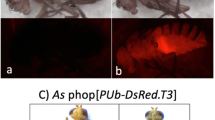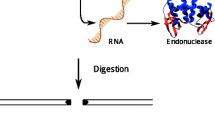Abstract
Transgenic insect technology will provide opportunities to explore the basic biology of a broad range of insect species in ways that will prove insightful and important. It is also a technology that will provide opportunities to manipulate the genotypes of insects of practical significance to the health and welfare of humans. TheHermes transposable element from the housefly,Musca domestica, is a short inverted repeat-type element related tohobo fromDrosophila melanogaster, Ac fromZea mays, andTam3 fromAntirrhinum majus. It has potential to become a versatile and efficient broad host-range insect transformation vector. The ability ofHermes to transpose when introduced into five species of diptera from four divergent families was tested using anin vivo, interplasmid transpositional recombination assay.Hermes was capable of transposing in all species tested, demonstrating thatHermes has a broad host-range. In addition, the rates of transposition were sufficiently high in all species tested to suggest thatHermes will be an efficient gene transfer vector in a wide range of insect species. TheHermes element also revealed a pattern of integration into the target substrate that permitted factors determining integration site selection to be identified. Primary nucleotide sequence of the integration site played a role as did proximity to preferred integration sites and the nucleosomal organization of the target.
Similar content being viewed by others
References
Aarts, M.G.M., W.G. Dirkse, W.J. Steikema & A. Pereira, 1993. Transposon tagging of a male sterility gene inArabidopsis. Nature 363: 715–717.
Atkinson, P.W., W.D. Warren & D.A. O'Brochta, 1993. Thehobo transposable element ofDrosophila can be cross-mobilized in houseflies and excises like theAc element of maize. Proc. Natl. Acad. Sci. USA 90: 9693–9697.
Berg, D.E. & M.M. Howe, Eds. 1989.Mobile DNA. Washington, D.C., American Society of Microbiology.
Blackman, R.K., M. Macy, D. Koehler, R. Grimaila & W.M. Gelbart, 1989. Identification of a fully-functionalhobo transposable element and its use for germ-line transformation ofDrosophila. EMBO J. 8: 211–217.
Brennan, M.D., R.G. Rowan & W.J. Dickinson, 1984. Introduction of a functionalP element into the germ-line ofDrosophila hawaiiensis. Cell 38: 147–151.
Bron, S., 1990. Plasmids.Molecular biological methods for Bacillus, pp. 75–174, edited by C.R. Harwood & S.M. Cutting, John Wiley & Sons, New York.
Calvi, B.R., T.J. Hong, S.D. Findley & W.M. Gelbart, 1991. Evidence for a common evolutionary origin of inverted repeat transposons inDrosophila and plants:hobo, Activator, andTam3. Cell 66: 465–471.
Cary, L.C., M. Goebel, B.G. Corsaro, H.G. Wang, E. Rosen & M.J. Fraser, 1989. Transposon mutagenesis of baculoviruses: analysis ofTrichoplusia ni transposon IFP2 insertions within the FP-locus of nuclear polyhedrosis viruses. Virology 172: 156–169.
Chang, A.C.Y. & S.N. Cohen, 1978. Construction and characterization of amplifiable multicopy DNA cloning vehicles derived from the P15A cryptic miniplasmid. J. Bacteriology 134: 1141–1156.
Coates, C.J., A.J. Howells, D.A. O'Brochta & P.A. Atkinson, 1996a. The 5′ regulatory region from theDrosophila pseudoobscura hsp82 gene results in a high level of reporter gene expression inLucilia cuprina embryos. Gene: 199–201.
Coates, C.J., K.N. Johnson, H.D. Perkins, A.J. Howells, D.A. O'Brochta & P.W. Atkinson, 1996b. Thehermit transposable element of the Australian sheep blowfly,Lucilia cuprina, belongs to thehAT family of transposable elements. Genetica 97: 23–31.
Coates, C.J., C.L. Turney, M. Frommer, D.A. O'Brochta & P.W. Atkinson, 1997. Interplasmid transposition of the mariner transposable element in non-drosophilid insects. Molec. Gen. Genet. in press.
Craig, N.L., 1995. Unity in transposition reactions. Science 270: 253–254.
Dean, D., 1981. A plasmid cloning vector for the direct selection of strains carrying recombinant plasmids. Gene 15: 99–102.
Engels, W.R., 1989. Pelements inDrosophila melanogaster. Mobile DNA, pp. 439–484, edited by D.E. Berg & M.M. Howe, American Society for Microbiology, Washington, D.C.
Feldmar, S. & R. Kunze, 1991. The ORFa protein, the putative tansposase of maize transposable elementAc, has a basic DNA binding domain. EMBO J. 1013: 4003–4010.
Franz, G., T.G. Loukeris, G. Dialektaki, C.R.L. Thompson & C. Savakis, 1994. MobileMinos elements fromDrosophila hydei encode a two-exon transposase with similarity to thepaired DNA-binding domain. Proc. Natl. Acad. Sci. USA 91: 4746–50.
Franz, G. & C. Savakis, 1991.Minos, a new transposable element fromDrosophila hydei, is a member of the Tc1-like family of transposons. Nucleic Acids Res. 19: 6646.
Fraser, M.J., L. Cary, K. Boonvisudhi & H.-G.H. Wang, 1995. Assay for movement of lepidopteran transposon IFP2 in insect cells using a baculovirus genome as a target DNA. Virology 211: 397–407.
Fraser, M.J., G.E. Smith & M.D. Summers, 1983. The acquisition of host cell DNA sequences by baculoviruses: Relation between host DNA insertions and FP mutants ofAutographa californica andGalleria mellonella NPVs. J. Virology 47: 287–300.
Gay, P., D.L. Coq, M. Steinmetz, T. Berkelman & C.I. Kado, 1985. Positive selection procedure for entrapment of insertion sequence elements in gram-negative bacteria. J. Bacteriology 164: 918–921.
Grzesiuk, E. & D. Carroll, 1987. Recombination of DNAs in Xenopus oocytes based on short homologous overlaps. Nucl. Acid Res. 15: 391–985.
Handler, A.M. & S.P. Gomez, 1996. Thehobo transposable element excises and has related elements in tephritid species. Genetics 143: 1339–1347.
Hashimoto-Gotoh, T., A. Tsujimura, K.-Y. Kuriyama & S. Matsuda, 1993. Construction and characterization of new host-vector systems for the enforcement-cloning method. Gene 137: 211–216.
Hehl, R., 1994. Transposon tagging in heterologous host plants. Trends in Genetics 10: 385–386.
Hesse, J.E., M.R. Lieber, M. Gellert & K. Mizuuchi, 1987. Extrachromosomal DNA substrates in pre-B cells undergo inversion or deletion at immunoglobulin V-D.-J joining signals. Cell 49: 775–783.
Hirt, B., 1967. Selective extraction of polyoma DNA from infected mouse cell cultures. J. Mol. Biol. 26: 365–369.
Inoue, S., H., Matsubara, & T. Yamanaka, 1985. Complete amino acid sequence of cytochromec from the honeybee,Apis mellifera, and evolutionary relationships of the honeybee to other insects on the basis of the amino acid sequence. J. Biochem. 97: 947–954.
Kassis, J.A., E. Noll, E.P. VanSickle, W.F. Odenwald & N. Perrimon, 1992. Altering the insertional specificity of aDrosophila transposable element. Proc. Natl. Acad. Sci. U.S.A. 89: 1919–1923.
Lampe, D.J. & H.M. Robertson, 1996. A purifiedmariner transposase is sufficient to mediate transpositionin vitro. EMBO J. 15: 5470–5479.
Lidholm, D., A. Lohe & D. Hartl, 1993. The transposable elementmariner mediates germline transformaton inDrosophila melanogaster. Genetics 134: 859–868.
Lohe, A.R. & D.L. Hartl, 1996. Germline transformation ofDrosophila virilis with the transposable element mariner. Genetics 143: 365–374.
Loukeris, T.G., I. Livadaras, B. Arca, S. Zabalou & C. Savakis, 1995. Gene transfer into the Medfly,Ceratitis capitata, using aDrosophila hydei transposable element. Science 270: 2002–2005.
Lozovskaya, E.R., D.I. Nurminsky, D.L. Hartl & D.T. Sullivan, 1996. Germline transformation ofDrosophila virilis mediated by the transposable elementhobo. Genetics 142: 173–177.
Maclean, N., Ed. 1994.Animals with novel genes. Cambridge, Cambridge University Press.
Martin, P., A. Martin, A. Osmani & W. Sofer, 1986. A transient expression assay for tissue-specific gene expression of alcohol dehydrogenase inDrosophila. Develop. Biology 117: 574–580.
Maryon, E. & D. Carroll, 1991. Characterization of recombination intermediates from DNA injected intoXenopus laevis oocytes: evidence for a nonconservative mechanism of homologous recombination. Molec. Cell Biol. 11: 3278–3287.
Maryon, E. & D. Carroll, 1991. Involvement of single-stranded tails in homologous recombination of DNA injected intoXenopus laevis oocyte nuclei. Molec. Cell Biol. 11: 3268–3277.
McGinnis, W., A.W. Shermoen & S.K. Beckendorf, 1983. A transposable element inserted just 5′ to aDrosophila glue protein gene alters gene expression and chromatin structure. Cell 34: 75–84.
O'Brochta, D.A. & P.W. Atkinson, 1996. Transposable elements and gene transformation in non-drosophilid insects. Insect Biochemistry and Molecular Biology 26: 739–753.
O'Brochta, D.A. & A.H. Handler, 1988. Mobility ofP elements in drosophilids and nondrosphilids. Proc. Natl. Acad. Sci. U.S.A. 85: 6052–6056.
O'Brochta, D.A., W.D. Warren, K.J. Saville & P.W. Atkinson, 1994. Interplasmid transpostion ofDrosophila hobo elements in nondrosophilid insects. Molec. Gen. Genet. 244: 9–14.
O'Brochta, D.A., W.D. Warren, K.J. Saville & P.W. Atkinson, 1996.Hermes, a functional non-drosophilid insect gene vector fromMusca domestica. Genetics. 142: 907–914.
Pinkerton, A.C., D.A. O'Brochta & P.W. Atkinson, 1996. Mobility ofhAT transposable elements in the Old World American bollworm,Helicoverpa armigera. Insect Molecular Biology. 5: 223–227.
Pryciak, P.M. & H.E. Varmus, 1992. Nucleosomes, DNA-binding protiens, and DNA sequence modulate retroviral integration target site selection. Cell 69: 769–780.
Rio, D.C., 1991. Regulation ofDrosophila P element transposition. Trends Genet. 7: 282–287.
Rohdendorf, B.B. 1974. The historical development of Diptera. Translated from the Russian by J.E. Moore & I. Thiele; edited by B. Hocking, H. Oldroyd, G.E. Ball, University of Alberta Press, Edmonton, 360pp.
Rommens, C.M. T., M.J.J. Van Haaren, H.J.J. Nijkamp & J. Hille, 1993. Differential repair of excision gaps generated by transposable elements of the ‘Ac family’. BioEssays 158: 507–512.
Roth, D.B., T.N. Porter & J.H. Wilson, 1985. Mechanisms of nonhomologous recombination in mammalian cells. Molec. Cell. Biol. 5: 2599–2607.
Rubin, G.M. & A.C. Spradling, 1982. Genetic transformation ofDrosophila with transposable element vectors. Science 218: 348–353.
Sambrook, J., E.F. Fritsch & T. Maniatis, 1989.Molecular cloning: A laboratory manual. Cold Spring Harbor Laboratory Press, Cold Spring Harbor.
Sanger, F., S. Nicklen & A.R. Coulson, 1977. DNA sequencing with chain-terminating inhibitors. Proc. Natl. Acad. Sci. USA. 74: 5463–5467.
Scavarda, N.J. & D.L. Hartl, 1984. Interspecific DNA transformation inDrosophila. Proc. Natl. Acad. Sci. USA 81: 7515–7519.
Selbitschka, W., S. Niemann & A. Puhler, 1993. Construction of gene replacement vectors for gram-bacteria using a genetically modified sacRB gene as a positive selection marker. Appl. Micro. and Biotech. 38: 615–618.
Smith, D., J. Wohlgemuth, B.R. Calvi, I. Franklin & W.M. Gelbart, 1993.Hobo enhancer trapping mutagenesis inDrosophila Reveals an insertion specificity different fromP elements. Genetics 135: 1063–1076.
Sokal, R.R. & F.J. Rohlf, 1981.Biometry. W.H. Freeman and Company, New York.
Spradling, A.C. & G.M. Rubin, 1982. Transposition of clonedP elements intoDrosophila germ line chromosomes. Science 218: 341–347.
Spradling, A.C., 1986. P element-mediated transformation, pp. 175–198 inDrosophila. A practical approach, edited by D.B. Roberts. IRL Press, Oxford and Washington, D.C., IRL Press.
Stellar, H. & V. Pirrotta, 1985. Fate of DNA injected into earlyDrosophila embryos. Develop. Biology 109: 54–62.
Streck, R.D., J.E. MacGaffey & S.K. Beckendorf, 1986. The structure ofhobo transposable elements and their insertion sites. EMBO J. 5: 3615–3623.
Sutcliffe, J.G., 1978. Complete nucleotide sequence of theEscherichia coli plasmid pBR322. Cold Spring Harbor Symp. Quant. Biol. 43: 77–90.
Takashi, A., N. Noguchi, S. Masanoni & M. Kono, 1987. Complete nucleotide sequence of pTZ12, a chloramphenicol-resistance plasmid ofBacillus subtilis. Gene 51: 107–111.
Vos, J.C., I. DeBaere & R.H.A. Plasterk, 1996. Transposase is the only nematode protein required for in vitro transposition ofTc1. Genes and Develop. 10: 755–761.
Warren, W.D., P.W. Atkinson & D.A. O'Brochta, 1994. TheHermes transposable element from the housefly,Musca domestica, is a short inverted repeat-type element of thehobo, Ac, andTam3 hAT element family. Genetical Res. Camb. 64: 87–97.
Yanisch-Perron, C., J. Vieira & J. Messing, 1985. Improved M13 phage cloning vectors and host strains: Nucleotide sequences of the M13mp18 and pUC19 vectors. Gene 33: 103–119.
Author information
Authors and Affiliations
Rights and permissions
About this article
Cite this article
Sarkar, A., Coates, C.J., Whyard, S. et al. TheHermes element fromMusca domestica can transpose in four families of cyclorrhaphan flies. Genetica 99, 15–29 (1997). https://doi.org/10.1007/BF02259495
Received:
Accepted:
Issue Date:
DOI: https://doi.org/10.1007/BF02259495




